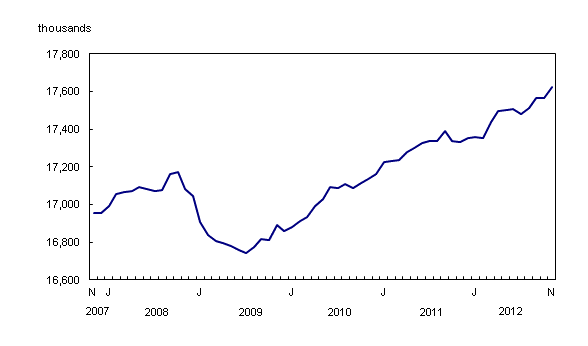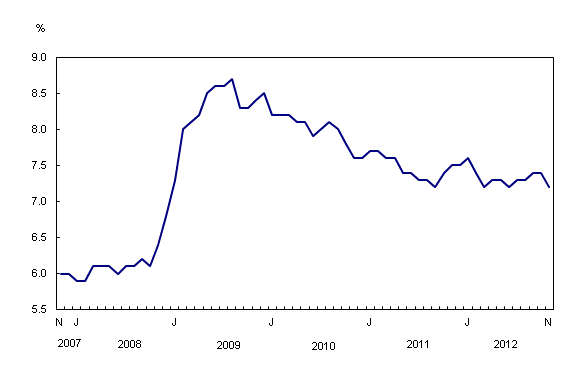Labour Force Survey, November 2012
Archived Content
Information identified as archived is provided for reference, research or recordkeeping purposes. It is not subject to the Government of Canada Web Standards and has not been altered or updated since it was archived. Please "contact us" to request a format other than those available.
Related subjects
-
[an error occurred while processing this directive]
Following little change in October, employment rose by 59,000 in November, the result of an increase in full-time work. The unemployment rate declined 0.2 percentage points to 7.2%.
Employment

Compared with 12 months earlier, employment increased 1.7% or 294,000, mostly in full-time work. Over the same period, the total number of hours worked rose 1.3%.
In November, employment increased in Ontario, Quebec, Alberta, Manitoba and Prince Edward Island. There was little change in the other provinces.
The number of private sector employees rose by 48,000 in November, while there was little change in public sector employment and self-employment.
Year over year, employment gains totaled 187,000 (+1.7%) among private sector employees, while public sector employment increased by 76,000 (+2.1%). Over the same period, the number of self-employed was virtually unchanged.
Among industries, employment increases in November occurred in accommodation and food services; retail and wholesale trade; professional, scientific and technical services; and agriculture. There were fewer workers, however, in manufacturing and 'other services' such as civic and professional organizations, personal services and repair and maintenance.
In November, employment increased among women aged 25 to 54 and youths aged 15 to 24.
Unemployment rate

Chart description: Unemployment rate
Provincial summary
Employment in Ontario rose by 32,000 in November, and the unemployment rate declined 0.4 percentage points to 7.9%. Compared with 12 months earlier, employment in the province was up 1.3%, all in full time, but below the national growth rate of 1.7%.
Employment in Quebec rose by 18,000, continuing an upward trend that began in August. The unemployment rate was 7.6% in November. Compared with 12 months earlier, employment growth in the province was 2.8%.
In November, employment rose by 10,000 in Alberta. At the same time, the unemployment rate declined 0.3 percentage points to 4.2%, the lowest among all provinces. Year-over-year employment growth in the province was 1.8%.
Employment in Manitoba increased by 5,500 in November, pushing the unemployment rate down 0.3 percentage points to 5.3%. Compared with 12 months earlier, employment in the province grew by 1.4%.
While employment in Newfoundland and Labrador was little changed in November, it increased 3.8% on a year-over-year basis, all in full time, and the highest growth rate among the provinces.
Industry perspective
In November, there were more people working in accommodation and food services, up 28,000, bringing employment in this industry back to a level similar to November 2011.
Employment in retail and wholesale trade rose by 25,000 in November. Recent increases were offset by declines earlier in the year, leaving employment in this industry similar to the level observed 12 months earlier.
There were more people working in professional, scientific and technical services in November, up 23,000. On a year-over-year basis, employment in the industry was little changed.
Employment in agriculture rose by 9,000 in November, partly offsetting a decline the month before. Agricultural employment is now at about the same level as 12 months earlier.
Following five months of little change, the number of workers in manufacturing declined by 20,000 in November. Despite this decrease, the number of factory workers rose 4.1% on a year-over-year basis, with most of the gains observed earlier this year.
In November, there were 15,000 fewer people employed in 'other services'. Compared with 12 months earlier, employment in this industry was little changed.
More women aged 25 to 54 and youths employed in November
Employment in November rose by 33,000 for core-aged people (25 to 54), particularly women (+23,000). On a year-over-year basis, employment among women aged 25 to 54 rose by 66,000 (+1.2%), similar to the increase for core-aged men (+68,000 or +1.1%).
Employment among youths aged 15 to 24 increased by 16,000 in November, and their unemployment rate fell 0.7 percentage points to 14.0%. With this increase, the employment level for this group was similar to that of 12 months earlier.
Although employment among persons aged 55 and over was little changed in November, it increased by 183,000 (+5.9%) on a year-over-year basis, driven in part by population aging.
Note to readers
The Labour Force Survey (LFS) estimates are based on a sample and are therefore subject to sampling variability. As a result, monthly estimates will show more variability than trends observed over longer time periods. Estimates for smaller geographic areas or industries also have more variability. For an explanation of sampling variability of estimates and how to use standard errors to assess this variability, consult the 'Estimates quality' section of the publication Labour Force Information (Catalogue number71-001-X, free).
The employment rate is the number of employed persons as a percentage of the population 15 years of age and over. The rate for a particular group (for example, youth aged 15 to 24) is the number employed in that group as a percentage of the population for that group.
The unemployment rate is the number unemployed as a percentage of the labour force (employed and unemployed).
The participation rate is the number of employed and unemployed as a percentage of the population. For more detailed information, see the Guide to the Labour Force Survey (Catalogue number71-543-G, free).
Unless otherwise stated, this release presents seasonally adjusted estimates, which facilitates comparisons by removing the effects of seasonal variations. For more information on seasonal adjustment, see Seasonal adjustment and identifying economic trends.
Revision
Seasonally adjusted estimates from the LFS will be revised using the latest seasonal factors, going back three years (January 2010 onwards). The revised estimates will be available on CANSIM (tables 282-0087 to 282-0094, 282-0100, 282-0116 and 282-0117) on February 1, 2013.
Available without charge in CANSIM: tables CANSIM table282-0001 to 282-0042, CANSIM table282-0047 to 282-0051, CANSIM table282-0054, CANSIM table282-0055, CANSIM table282-0060 to 282-0063, CANSIM table282-0069 to 282-0089, CANSIM table282-0092 to 282-0095, CANSIM table282-0100 to 282-0121 and CANSIM table282-0200 to 282-0219.
Definitions, data sources and methods: survey number survey number3701.
A more detailed summary, Labour Force Information (Catalogue number71-001-X, free), is now available online for the week ending November 10. From the Key resource module of our website under Publications, choose All subjects, then Labour.
Data tables are also now available online. From the Subject module of our website, choose Labour.
The next release of the Labour Force Survey will be on January 4, 2013.
For more information, contact us (toll-free 1-800-263-1136; infostats@statcan.gc.ca).
To enquire about the concepts, methods or data quality of this release, contact Jason Gilmore (613-951-7118; jason.gilmore@statcan.gc.ca) or Jeannine Usalcas (613-951-4720; jeannine.usalcas@statcan.gc.ca), Labour Statistics Division.
- Date modified:
